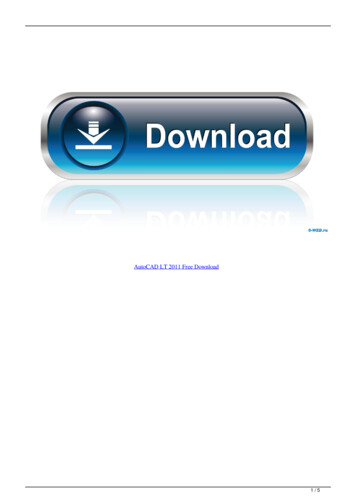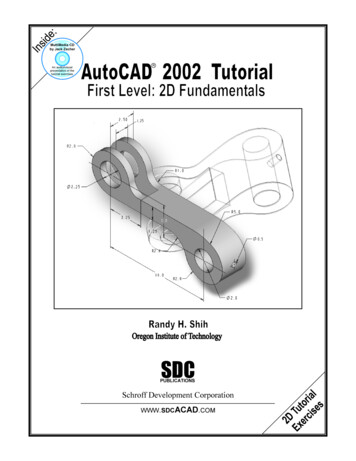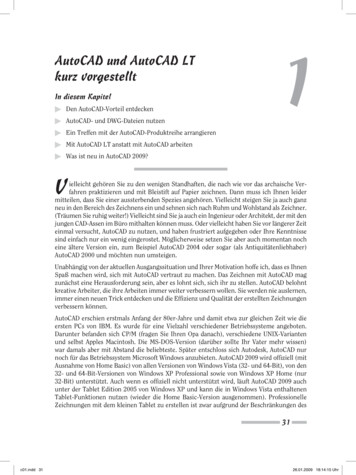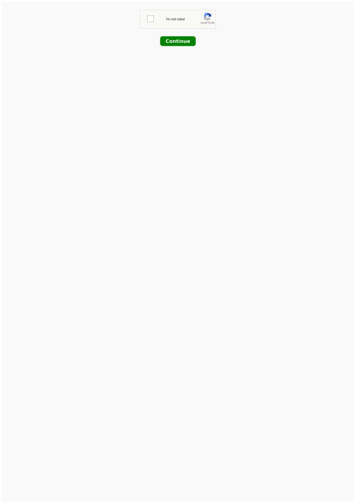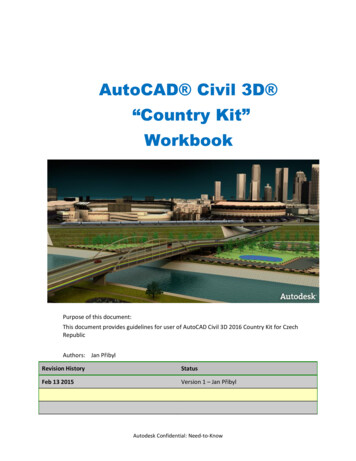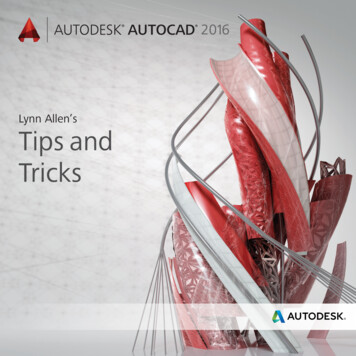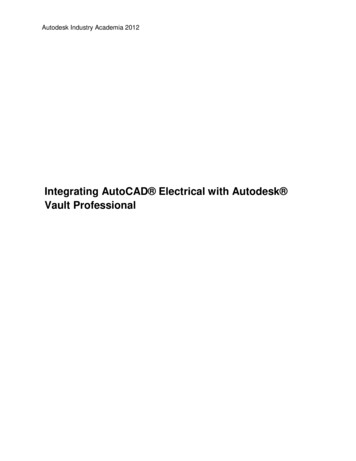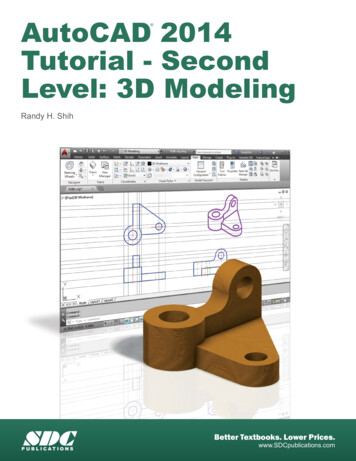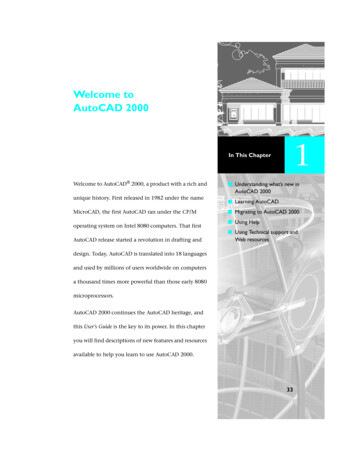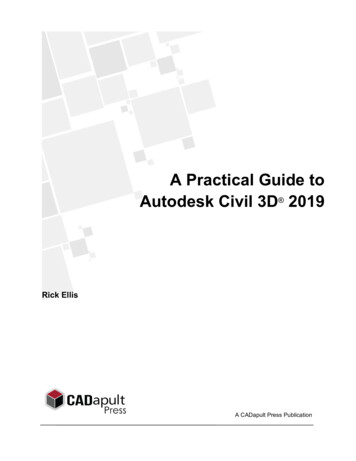
Transcription
Continue
Autodesk autocad civil 3d 2018 tutorial pdf free online download fullWe can do that either by right-clicking on Surface in the Prospector and selecting New or by using the Create Surface command from the ribbon. The Surface Properties window opens and displays four tabs. Let's see how to apply styles to the surfaces in the drawing.infratechcivil.com/courses NOTES 4 SURVEYING 4.1 Introduction In general, most civil engineering jobs involve a phase of field data collection and a stakeout of design data for construction. Then, assign the layer to VNODE-SSWR. The last tab gives us a summary of most things we've talkedabout in this window. The AutoCAD Civil 3D tool palette and tool catalogs provide a variety of preconfigured subassemblies, such as travel lanes, curbs, shoulders, and ditches."Subdivision "An unimproved tract of land surveyed and divided into parcels for purposes of sales." Superelevation "The change in cross slope or 'banking' on a horizontal curve to help counterbalance the centrifugalforce of a vehicle traversing the curve. In the editor, highlight Material Table, then select Material Name in the Properties drop-down menu. 369 CREATING SAMPLE LINES . 62 DESCRIPTIONKEYS. They are used to group commands with similar functions. We will see later how to create them. This time, for Label Type, select the Entire Network Profile and click Add. Furthermore, the stylesand labels defined in the Description Keys set are assigned to each point in accordance to their raw description. Click Next to accept 238 infratechcivil.com/coursesNOTES current values. Call the boundary Flower Village Boundary for example. v. Also note that after creating the alignment, you can change it by using the alignment propertieswindow. The Band Details tab is where most of the setup is done. 36. However, he or she may also be required to design the underground wet system, especially the wet utilities like watermains, sanitary and stormwater sewers. If you have already closed it, reopen it and activate the Analysis tab, the 3rd tab from left to right. So, instead, we aregoing to anchor it to FG – Elev. Once we do that, the reference surface elevation code will be applied. In the Surface Properties dialog box, on the Information tab, for Surface Style, select Elevation Banding (2D). After that, use the major and minorlabel set, to display tick marks at minor stations and values at major stations.20. Remember, we have used a set ofsubassemblies that comes with Civil 3D, out-of-the box. First, from the ribbon, use the Create Alignment from Objects command. In the new Create Sample Line Group dialog box, select a Civil 3D object that can be sampled, such as surfaces, corridors, andpipe networks. We can now see the bearing, distance and angle labels of the site boundary polyline. If we needed to add more points, we would continue and specify a new point. 145 infratechcivil.com/coursesNOTES 8. Before saving, you have an option to change the file format to either HTML, Word document, Excel sheet, text or pdf. In the current situation, we will choose all existing surfaces and the corridor. First, gothe component tab to set the parameters, and manage the visibility on the Display tab. It is obvious that the curves are already created in our case when we first created the baseline. Select to delete or adjust, by using the handles on any parcel that is too big, too small,irregularly shaped or located on the wrong side of the road frontage. Especially when designing rail tracks, highways or airfields. First, select the profile view in the drawing. Ideally, we would like to have the road grade at that location so that we cancarry it out a few tens of meters or feet before any change of slope.4. Then, you have the Code Set Style, which will determine the styles of the different components of the corridors,like points, lines, and areas. o This will take you to the drawing area to click on the point you would like to use as a start point. The Summary tab, which gives a general overview of the different parameters of the Style.164infratechcivil.com/courses NOTES 17. This would especially be the case if we were only building the road and develop the lots later. That's exactly what we are trying to do, change the surface. Then, right-Click on the Edits section 9. Generally, the smaller the frequency, the more precise the corridor is, especially inthe curved regions of the corridor. 71 infratechcivil.com/coursesNOTES 6. Then, include the raw descriptionsin the definition. To make the tags easier to reference between the drawing and the tables, we can sort the Tables in an ascending or descending order. In the Water Drop window, change the layer to the watershed layer C-TOPO-WSHD and choose 3D Polyline for Path Object Type. You will be notified at the command line of the total number ofobjects selected. 358 infratechcivil.com/coursesNOTES 4. 138 Water Drop Path. 148 Surface Styles:. Select Storm Sewer, right-click and choose Edit. Then, specify the type of roadway that the assembly will support. Usethe * wildcard to include points such as DG-OG, DG-CL, DG-FFE, and so forth. 236 PROPOSED PROFILES (LAYOUT PROFILE) . When dealing with single baseline corridors, it would be better to add a boundary from . The topsoil can be reused at a later stage onthe current project or a separate one. In the Frequency to Apply Assembly dialog box, apply the following values. We typically also add a few design commands that we frequently use. So, we need to trick it and put a microscopic value, say 0.001. In this case, multiple segments. The Ambient Settings tab specifies thecurrent file’s units and parameters. To create a point manually, launch the Point Creation Tools. If we need to add or reduce the pipe cover, we can always raise or lower the feature line by selecting it and using the raise/lower command. Make sure you click the “ ” sign to the left ofthe baseline name to expand the list of regions and their information.8.4 Profile Styles Like most of Civil 3d entities, profiles and profile views are controlled by styles. On the General page, we can specify general details for the intersection object, suchas name, styles and corridor type. Let's use the automatic method. Click on the line between A and B. To change it, simply click on Compose label; and change the content in the Label Style Composer. These are just a few questions that must be answered, or at least asked during the conceptual phase. We will enter20m or 50ft along both tangents and curves. Keep entering Enter at the command line until it becomes blank: 4. 50 infratechcivil.com/coursesNOTES 5.271 infratechcivil.com/coursesNOTES 9.2 Corridor Creation (proposed road) Now that we have the three required basic elements (alignment, profile, and cross-section), we cancreate a road model or corridor. 2.8 Status Bar Just below the Command Line, we have the Status Bar. One is to create two lines perpendicular to the curb line at each end of the street.Then, draw a line from the midpoint to the midpoint of these two lines.14. First, processing and analyzing existing data. Let's write down the value of the Mean Elevation. Right-click on Breaklines to select Add. Continued education and certification services to help professionals stand out among peers. It all dependson which option is easier for you. The volumes have now been computed. It's self-explanatory, but this will effectively convert all labels to tag mode. Typically, using such data is a cost-effective way to perform a preliminary design or analysis. Pressure Part Networks 11. Click on it to add it to the selection set. When the detailed design is completed,we need to estimate the project quantities by using material lists.5. That will include asphalts, concretes, and others. They are typically published by the federal transportation authority. After the interface, thenext logical step is to learn how to set up a project through the creation of styles and templates.31 infratechcivil.com/courses NOTES 31. To do that, in the Table Creation windows we need to split the table as needed. Instead of creating a set number of points, we can createpoints at set intervals, for example, a point every 30m or 100ft. 36 infratechcivil.com/coursesNOTES 10. We can use them to display design information, including profileelevations, cut and fill data, pipe networks, and much more. That takes care of the surface identification. When prompted at the command line to specify a region to edit, click inside the corridor, around the cul-de-sac area. That option automatically updates the tables, should anything change with the parcels. Now, draw a polyline that crosses ourproposed site, from south of Jasmine Blvd all the way to the river. In this case, the command needed would be Measure Alignment: 2. 178 Slide Line – Create . Next, click on thehorizontal arrow, to overwrite the current content. We refer you to Infratech’s Advanced Road Design course for more on these tools. Activate the Pipes tab. So, we need to be able to differentiate them. It should be noted that Autodesk has other software, such as Infraworks, that may be better suited thanCivil 3D, for this phase. We then need to choose the default template provided out-of-the-box by Civil 3D, or choose our own, if we have created one. 229 ALIGNMENTS TABLES. NOTES Create a parcel from the main lot (blue boundary line). In the new window, assign the name to the profile, give it a description andchoose a label set. Often time, we will need to stake out the design intent using points. Simply select them and move them like here, for example. Next, click on the eastern end of Rose Drive, on both sides of the centerline, around station 0 260m or 0 850’. In front of the elevation code, enter the surface nameor initials, like EG. When it’s all said and 198 infratechcivil.com/courses NOTES done, your parcels should be numbered from 1 to 40, give or take, depending on your adjustments.Each part also needs to reference the appropriate alignment. There are also other ways to access the Options windows, and the Application menu is just one of them. Click86 infratechcivil.com/courses NOTES 4.5 Creating points with data coordinates Let's assume we have a monument (or survey benchmark) for which we have coordinates available on paper and have just learned about their existence.163 infratechcivil.com/courses NOTES 15. 95 CREATING POINTS ON AN ALIGNMENT . 369 11.1 11.2 11.3 11.4 11.5 11.6 12INTRODUCTION . Reopen the Point Creation Toolbar, if you have closed it. One last click on the Cycle Through arrow, and we complete the cycle and return to the original state of the ribbon. However, it just looks like we can do better thanthis. In this table, we can check our radiuses, entities directions, start and end stations, and so forth. With this option, we will rebuild the surface and continue to get warnings every time we make changes to the surface definition. How great is that? Afterward, double-click on Area Report,for instance. Examples of pipe rules can include the minimum or maximum pipe slope, minimum cover, minimum or maximum pipe length, etc. In this project, we will create cross-sections at 20m or 50ft intervals along Rose Drive. 194 infratechcivil.com/coursesNOTES 7. For example, we would like to separate the existing ground points from the design points.69 infratechcivil.com/courses NOTES 3.5 Description Keys One of the most common land surveying post-processing operations is to assign symbols to survey points to give them adistinctive and selfexplanatory appearance. Now, zoom to the intersection of Lavender Court and Rose Drive. Then you can, once again, edit the alignment or add additional data. This will allow us to have back-to-back abutting lots. The Layout tab is where most of the label creation action takesplace. The second tab is Definition: it allows you to specify definition parameters of the surface. You can do it manually by grabbing the PVI point and slide it up, with your Ortho mode activated. Let's close this window. First, we can get information,by an approximation, at locations not originally surveyed; 2. Breakline "A line used to connect the data representing a distinct surface feature, like a ridge line, edge of pavement, toe of a slope, the centerline of a road, or flowline of a ditch or stream.33 infratechcivil.com/courses NOTES 36. These properties vary depending onthe type of label. Next, we need to change conditions to the contrary of the cut material, and lastly, we need to change the Quantity Type to Fill.370 infratechcivil.com/courses NOTES 6. We obviously don’t need manholes at all the shown vertices.249 infratechcivil.com/courses NOTES 8.6Profile Style The profile is the line representing the vertical alignment. Let's expand it by hovering over it. However, at this stage, the existing and stripped surfaces are basically the same. Point Styles In general, most manipulations of styles and settings are done from the Settings tab of the Toolspace. The Layout tab, which defines the content of thelabel's text. These are all the points used for the surface triangulation, cogo points, breakline vertices, etc. You are then requested to specify the Start Point of frontage. Renumbering tags is typically done when all of the design is completed, and alltags in the drawings should be numbered in ascending order. First, let’s insert more sections. It would be neat, for example, to display the name of each material in the table. First, Open the 08.01-Profiles dwg file in Lesson 08 practice folder. Now, we are going to learn how to usefixed and floating line and curve entities. This means how far left or right of the alignment centerline we want to sample. o For the profile, choose Proposed Rose Drive. o Check the Automatically add segments labels checkbox. For example, we canadd the name of the municipality at the end of the assembly, such as adding the suffix FB for Flower Bay. At the command line, you are prompted to select a surface to annotate. Next, we must specify the endpoint of the frontage. To do that, first, temporarily drag the corridor south, to cover the points area. Next, youare prompted for Endpoint. Besides, if we master this process, we will be able to create corridors in many other circumstances. In Civil 3D, section data is defined and displayed using sample lines grouped in a collection called a sample line group. On the other hand, maybe we don’t want to use certain sources in the sections. Two residential parcelsand another one representing the road right-of-way. Now let's turn on the contour layer to bring in the contours data. After that, type in the known coordinates of the point you selected, in the drawing in the previous step. More advanced users can also find value in this course, as it will help them reinforce their capabilities and most likely learn moreefficient techniques to accomplish some tasks. In any case, we have already set our design criteria, so there little that we should worry about for now.206 infratechcivil.com/courses NOTES 22.So, in the Quantity Takeoff Criteria window, switch to the Information tab and change the Name simply to Materials. But, the existing and proposed pavements don’t necessarily have the same width.infratechcivil.com/courses The option of using pre-existing AutoCAD blocks is particularly useful in a situationwhere we want to choose an existing block from an external AutoCAD file. We have also projected these two networks in their respective profiles and added labels in plan and profile views. Select the road parcel, right- click, and click Edit Area Selection Label Style. We have now seen one of the most commonly usedmethods to define a surface, Point Groups. 20 infratechcivil.com/coursesNOTES 4. Right-click and select Add. Let's assume that we obtained the contour data before the topographicalsurvey. We will be able to change the direction of the alignment. As expected, the adjusted volume is 10% more. The Automatic option specifies the full station range for the horizontal alignment. Civil 3D corridors allow us to create these models for design projects such as roadways, highways, railways and more. 44 infratechcivil.com/coursesNOTES 2.6 Drawing Area The Civil 3D drawing area is the central rectangular area where most of the action takes place. It’s worth mentioning that regular AutoCAD commandssuch as break and trim will not work on feature lines. 182infratechcivil.com/courses NOTES 8. Expand Create Ground data section. Exactly like we specified in the Curve and Spiral Settings, whenever we create two subsequent tangents. That's why it's called a Quick Profile. Press Escape to end thecommand184 infratechcivil.com/courses NOTES16. In this case, choose the Lavender Court alignment. And lastly, the Final Surface: This is the finished or finalgrade surface of the site. As usual, later, you can make changes to any parameter if you wish to adjust. In general, this will involve collecting field data through the process of land 5 infratechcivil.com/coursesNOTES surveying. Next, we need to create a Site. 183 infratechcivil.com/courses NOTES12.15. Now, we have an alignment, a profile, and subassembly. Choose the appropriate point file format. Then, right-click and select Copy to 33. Here we can view and change the settings for all the profiles associatedwith the parent alignment of the profile view. 159 INTRODUCTION . One more thing we can do from the application menu is to to access the current drawing's global options. Among the types of labelsyou can add are: o Major and Minor labels. We will make this point clear in a minute. Then go to the surface properties and apply the contours style on the information tab. Now let's start creating the parcels fronting Lavender Court. We can even estimate cut and fill by choosing todisplay the difference between Section 1 and 2.290 infratechcivil.com/courses NOTES 13. Someone else can then use these stakeout reports to place (or adjust) the stakes at the site."Station "A distance along a horizontal alignment." Style "A logical collection of settings that applies to a class of objects. When prompted, select the Existing Ground surface and click OK. Creating tangent andfloating entities is one of the main benefits of the Alignment layout tools. 214 ALIGNMENT LABELS .124 infratechcivil.com/courses 6. Our start is now set.Let's see how to use a couple of these edit operations. Afterward, enter the profile creation settings in the Create Profile dialog box.5.9. Once we are satisfied with the size of the parcels and the layout of the segments, we can renumber the parcels. 256 infratechcivil.com/coursesNOTES Once again, let’s summarize. The Select Similar command is a very useful tool to select objects sharing the same properties (type, layers, colours, and so forth) 11. This is done from the surface's statistics.Let's check what happens to the points for which a description key has been created. First, let's change the name of the default text component from Surface Elevation to FG – Elev. Click on one of the No options in the Draw column to convert alloptions from No to Yes. To populate the elevation data, we simply need to assign surfaces to the different bands, so they know which elevation to display. That adds the boundary automatically from the corridor extents. If we type Line, for example, it brings up a few suggestions regarding the word line. In the drawing, we now see the DG-CL-J pointstanding out due to the applied Temp style. Select it, right-click and Edit. Make sure the incoming catchbasins inverts are at least at the same elevations as the sewer pipes and that they have a positive slope. This gives us a clue about the location of the cul-de-sac on the alignment. Next, run the frontage line alongthe Violets Circle right-of- way, from the top left corner to the start of the cul-de-sac.6. 20 RIBBON. For Pipe to create, choose a 450mm or 18in size pipe. On the Object Layer tab, we can specify default layers for various objects; when we create an object, a Civil 3D point for instance, it willautomatically be placed on the layer specified here. Then, from the Object Snap tab, select the modes to activate. The second time would be to accept the alignment direction. We want to create a few high-end single-family units. 24. Click OK, and all parts should now appear in the profile view. Let's also addlabels at horizontal geometry points, grade breaks and curves. The point group EG is now created, and we see that it is added to the point groups collection in the Prospector. We can also select the Polygon option and click on a pre-existing closed polyline. Let's focus on the Createtab, the default one. In some cases, the surveyor is solely responsible for collecting the data while the design team will create the model. Just like we did on the Start window.4. The new intersection is created as expected. Next, we need to adjust the curb returns on the Geometry Details page. 44 DRAWING AREA. By simply typing that word, we have a suggestion to run the Rectangle command from the ribbon, and many other options. In the next window, set the curve incrementto 0.5m or 2ft. At these locations, we want to display the proposed elevation and the existing ground elevation. Accept default layers.7. In this project, we only have one site, so our feature line will reside in the Flower Village II site. You will notice that our table doesn’t necessarilystart with label C1 for curves or L1 for line segments. Switch to the Parameters tab in this window for more options for modifying the corridor. We will be back right here once we let Civil 3D know what to do with the changes. To do that,309 infratechcivil.com/courses NOTES 39. Once the Tool palettes are displayed, you can start creating thesubassemblies. Now, let's explore a couple of the Alignment Layout Tools. Last, click on OK. On the Sample Line Tools, create new sample lines By range of stations.16.Renumber Points: As we Apply DescriptionKeys: Change Point Datum: We add and delete points, point As we create points and need to change a datum for numbers get offset. To keep update the description Key a tidy point group, we may Set, updates to both may be need to renumber them. Depending on the project’s setup,the survey team may be responsible for collecting the data, make necessary adjustments and create a usable digital terrain model. Now, we need to enter the network details in the Create Pipe Network from Object window. On the Ribbon launch the command to create parcels by layout, the Parcel Creation Tool.Then, click approximately between the two future catchbasins, on the feature line. 18. This will make it clear that this component provides elevations for the FG – Finished Ground. A few reference points, from A to G, have been created for us to use. Modifications can be made here as well. 17infratechcivil.com/coursesNOTES 11. That brings up the Add Label dialog box. The last page would have been the Section View Tables where we could set volume tableproperties for the section view. The Label Style Composer window will appear with the following tabs: i. This c
Autodesk autocad civil 3d 2018 tutorial pdf free online download full We can do that either by right-clicking on Surface in the Prospector and selecting New or by using the Create Surface command from the ribbon. The Surface Properties window opens and displays four tabs. Let's see how to apply styles to the surfaces in the drawing.

